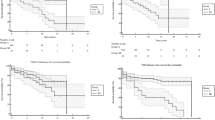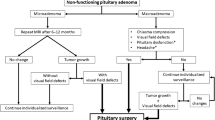Abstract
Purpose
Hypopituitarism and tumor growth are rare in patients with non-functioning pituitary microadenomas (NFPmA). However, patients often present with non-specific symptoms. The aim of this brief report is to examine presenting symptomatology in patients with NFPmA compared to patients with non-functioning pituitary macroadenomas (NFPMA).
Methods
We performed a retrospective review of 400 patients (347 NFPmA and 53 NFPMA) who were conservatively managed; no patients had indications for urgent surgical intervention.
Results
Average tumor size was 4.5 ± 1.9 and 15.5 ± 5.5 mm for NFPmA and NFPMA, respectively (p < 0.001). At least one pituitary deficiency was present in 7.5% of patients with NFPmA and 25% of patients with NFPMA. Patients with NFPmA were younger (41.6 ± 15.3 vs. 54.4 ± 22.3 years, p < 0.001) and more commonly female (64.6 vs. 49.1%, p = 0.028). There was no significant difference reported for similarly high rates of fatigue (78.4% and 73.6%), headache (70% and 67.9%), and blurry vision (46.7% and 39.6%). There were no significant differences in comorbidities.
Conclusion
Despite smaller size and lower rate of hypopituitarism, patients with NFPmA presented with a high prevalence of headache, fatigue, and visual symptoms. This was not significantly different from patients with NFPMA who were conservatively managed. We conclude that symptoms of NFPmA cannot fully be attributed to pituitary dysfunction or mass effect.
Similar content being viewed by others
References
Melmed S, Kaiser UB, Lopes MB, Bertherat J, Syro LV, Raverot G, Reincke M, Johannsson G, Beckers A, Fleseriu M, Giustina A, Wass JAH, Ho KKY (2022) Clinical Biology of the Pituitary Adenoma. Endocr Rev 43(6):1003–1037. https://doi.org/10.1210/endrev/bnac010
Han AJ, Varlamov EV, Fleseriu M (2022) Nonfunctioning Pituitary Microadenomas: Should Imaging Interval be Extended? A Large Single-center Cohort Study. J Clin Endocrinol Metab 107(3):e1231–e1241. https://doi.org/10.1210/clinem/dgab748
McHugh ML (2013) The Chi-square Test of Independence. Biochem Med 23(2):143–149. https://doi.org/10.11613/bm.2013.018
Iglesias P, Arcano K, Trivino V, Garcia-Sancho P, Diez JJ, Villabona C, Cordido F (2017) Prevalence, Clinical Features, and Natural History of Incidental Clinically Non-Functioning Pituitary Adenomas. Horm Metab Res 49(9):654–659. https://doi.org/10.1055/s-0043-115645
Melmed S (2020) Pituitary-Tumor Endocrinopathies. N Engl J Med 382(10):937–950. https://doi.org/10.1056/NEJMra1810772
Orija IB, Weil RJ, Hamrahian AH (2012) Pituitary incidentaloma. Best Pract Res Clin Endocrinol Metab 26(1):47–68. https://doi.org/10.1016/j.beem.2011.07.003
Abe T, Matsumoto K, Kuwazawa J, Toyoda I, Sasaki K (1998) Headache associated with pituitary adenomas. Headache 38(10):782–786. https://doi.org/10.1046/j.1526-4610.1998.3810782.x
Levy MJ, Jager HR, Powell M, Matharu MS, Meeran K, Goadsby PJ (2004) Pituitary volume and headache: size is not everything. Arch Neurol 61(5):721–725. https://doi.org/10.1001/archneur.61.5.721
Fleseriu M, Yedinak C, Campbell C, Delashaw JB (2009) Significant headache improvement after transsphenoidal surgery in patients with small sellar lesions. J Neurosurg 110(2):354–358. https://doi.org/10.3171/2008.8.Jns08805
Freda PU et al (2020) Presenting Features in 269 Patients With Clinically Nonfunctioning Pituitary Adenomas Enrolled in a Prospective Study. J Endocr Soc 4(4):bvaa021. https://doi.org/10.1210/jendso/bvaa021
Langlois F, Manea A, Lim DST, McCartney S, Yedinak CG, Cetas JS, Fleseriu M (2019) High prevalence of adrenal insufficiency at diagnosis and headache recovery in surgically resected Rathke’s cleft cysts-a large retrospective single center study. Endocrine 63(3):463–469. https://doi.org/10.1007/s12020-018-1784-0
Langlois F, Varlamov EV, Fleseriu M (2022) Hypophysitis, the Growing Spectrum of a Rare Pituitary Disease. J Clin Endocrinol Metab 107(1):10–28. https://doi.org/10.1210/clinem/dgab672
Cennamo G et al (2015) Evaluation of the retinal nerve fibre layer and ganglion cell complex thickness in pituitary macroadenomas without optic chiasmal compression. Eye 29(6):797–802. https://doi.org/10.1038/eye.2015.35
Erdinest N, London N, Lavy I, Morad Y, Levinger N (2021) Vision through Healthy Aging Eyes. Vision 5(4):46. https://doi.org/10.3390/vision5040046
Huang W, Moltich ME (2018) Management of nonfunctioning pituitary adenomas (NFAs): observation. Pituitary 21(2):162–167. https://doi.org/10.1007/s11102-017-0856-0
Funding
No funding was received to assist with this project.
Author information
Authors and Affiliations
Corresponding author
Ethics declarations
Ethical approval
This is a non-interventional retrospective review of medical chart records. All study protocols were approved by the Oregon Health and Science University Institutional Review Board (IRB; IRB00003480).
Informed consent
The study protocol has a waiver of consent as determined by the Oregon Health and Science University Institutional Review Board, Oregon Health & Science University, Portland, Oregon, USA.
Conflict of interest
The authors have no relevant financial or non-financial interests to disclose.
Additional information
Publisher’s note
Springer Nature remains neutral with regard to jurisdictional claims in published maps and institutional affiliations.
Rights and permissions
Springer Nature or its licensor (e.g. a society or other partner) holds exclusive rights to this article under a publishing agreement with the author(s) or other rightsholder(s); author self-archiving of the accepted manuscript version of this article is solely governed by the terms of such publishing agreement and applicable law.
About this article
Cite this article
Han, A.J., Fleseriu, M. & Varlamov, E.V. Symptoms at presentation in conservatively managed patients with non-functioning pituitary adenomas. Hormones 22, 305–309 (2023). https://doi.org/10.1007/s42000-023-00444-8
Received:
Accepted:
Published:
Issue Date:
DOI: https://doi.org/10.1007/s42000-023-00444-8




